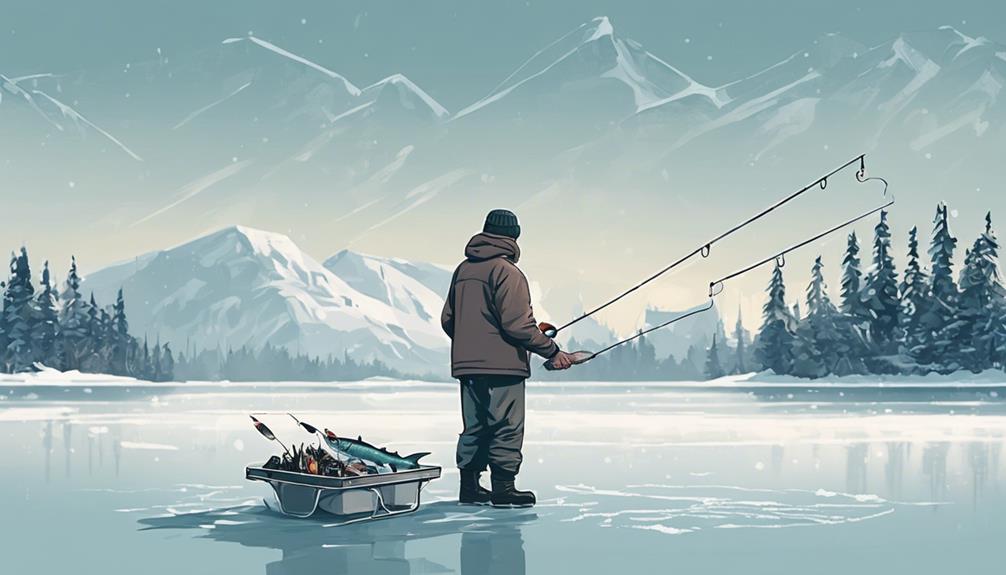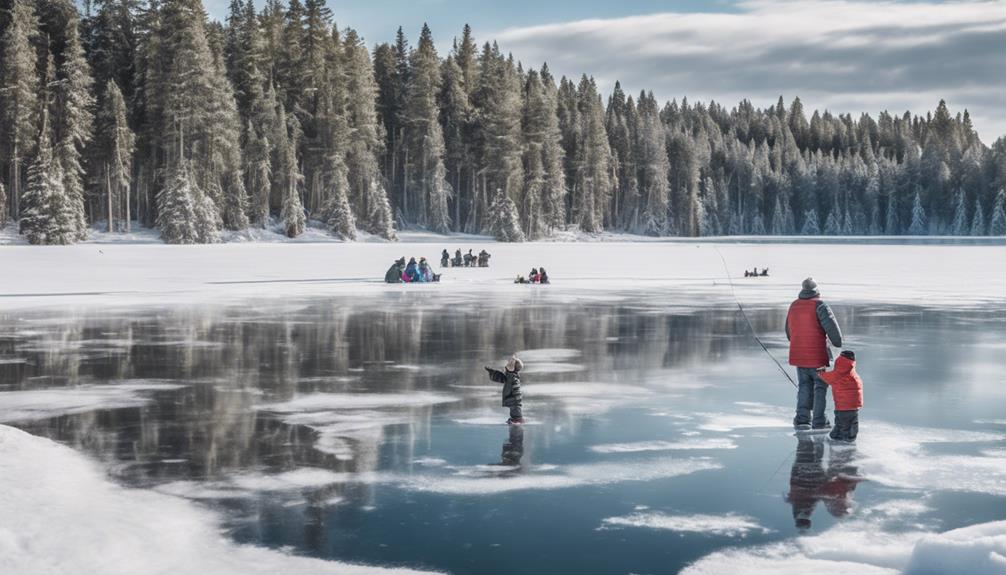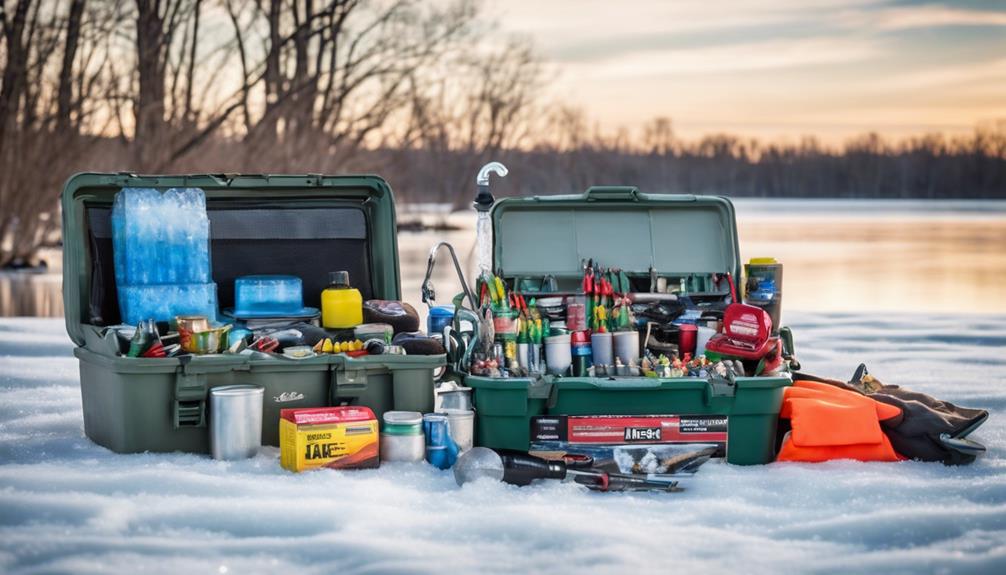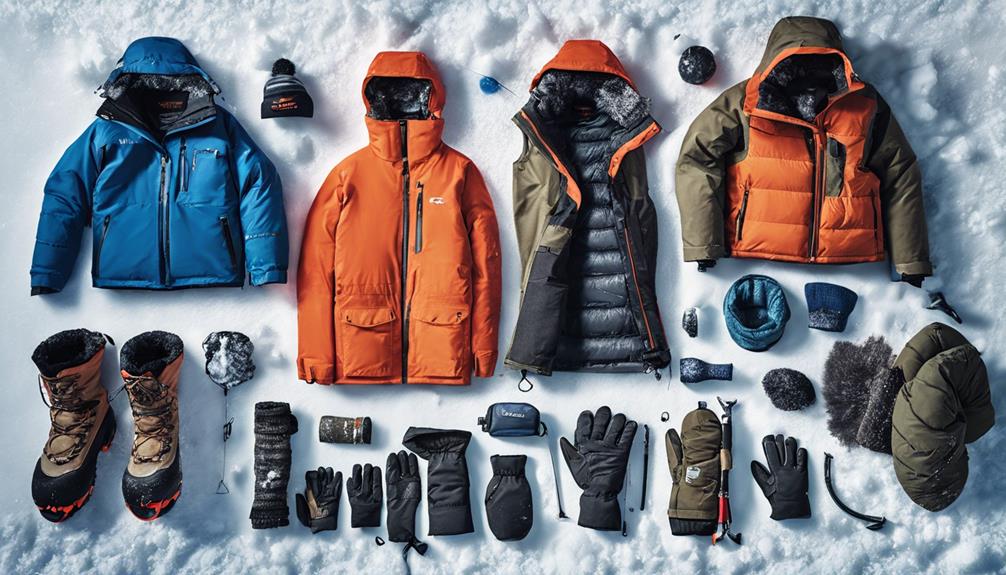When embarking on your ice fishing journey, think of these steps as pillars that will support your newfound venture.
Each step is crucial in laying a solid foundation for your experience on the ice.
From understanding the basics to preparing your catch, you'll find that mastering these essential elements can make all the difference in your success.
But remember, there's one key step that can truly make or break your ice fishing escapade.
Understanding Ice Fishing Basics
To begin your ice fishing journey, grasp the fundamental basics of this unique sport. Safety is paramount when venturing onto frozen waters. Always remember to check the thickness of the ice before stepping out. A minimum of 4 inches of clear ice is generally considered safe for ice fishing. However, this can vary depending on factors like temperature and presence of snow. Ensure you have essential safety equipment like ice picks, a life jacket, and a first aid kit readily available. Before each outing, inform someone of your plans and expected return time for added precaution.
Equipment maintenance is key to a successful ice fishing experience. Regularly inspect your gear for any signs of wear and tear. Check your ice auger to ensure it's sharp and in good working condition. Dull blades can make drilling through the ice a tedious task. Keep your fishing rods clean and lubricated to prevent freezing in frigid temperatures. It's also crucial to regularly check your ice shelter for any damage and make necessary repairs promptly. Properly maintaining your equipment not only prolongs its lifespan but also ensures your safety while out on the ice.
Choosing the Right Gear
Ensure your ice fishing experience is successful by selecting the right gear tailored to your needs and preferences. When it comes to gear maintenance, remember that proper care and upkeep can significantly extend the lifespan of your equipment. After each use, make sure to clean your gear thoroughly to remove any ice, dirt, or debris that could cause damage.
Inspect your gear regularly for any signs of wear and tear, such as frayed lines or rusted hooks, and replace or repair them as needed to ensure optimal performance on your next outing.
Equipment storage is another crucial aspect to consider when choosing the right gear. Properly storing your ice fishing equipment can help prevent damage and prolong its usability. Make sure to dry all your gear thoroughly before storing it to prevent corrosion or mold growth.
Invest in storage solutions such as tackle boxes, rod cases, and shelters to keep your gear organized, protected, and easily accessible for your next ice fishing adventure.
Identifying Safe Ice Conditions
When stepping onto the ice for your next ice fishing adventure, always prioritize safety by accurately identifying the conditions for safe ice. Checking thickness and testing strength are crucial steps to ensure your well-being while out on the frozen water.
To check the ice thickness, use an ice auger to drill a hole and measure the depth. A minimum of 4 inches of clear ice is generally considered safe for ice fishing. However, if you plan to take a snowmobile or ATV onto the ice, you'll need at least 5-7 inches of ice. For vehicles, aim for a thickness of 8-12 inches. Remember, these are just guidelines, and ice conditions can vary, so always err on the side of caution.
Testing the strength of the ice is equally important. Look for cracks, bubbles, or variations in color, as they can indicate weak spots. If the ice is white or opaque, it may be less strong than clear ice. To test the strength, gently tap the ice in front of you with a spud bar or ice chisel to check for any hollow sounds, which could signal thin ice.
Learning Ice Fishing Techniques
Start honing your ice fishing skills by mastering the art of setting up tip-ups in strategic locations on the ice. Ice fishing safety is paramount, so always ensure that the ice is thick enough to support your weight and equipment before venturing out. Remember to wear appropriate clothing and carry safety gear like ice picks and a floatation device in case of emergencies.
Understanding fish behavior is crucial for a successful ice fishing trip. Fish tend to be more sluggish in cold water, so you may need to adjust your techniques accordingly. Start by learning about the types of fish in the area you're fishing, their feeding habits, and the best times to catch them. This knowledge will help you choose the right bait and presentation to attract the fish to your tip-ups.
As you set up your tip-ups, consider the depth of the water and the structure of the lake bed. Different fish species prefer different depths and habitats, so positioning your tip-ups strategically can increase your chances of a good catch. Experiment with different locations until you find the spots where the fish are most active.
Selecting the Perfect Spot
Choosing the ideal location plays a crucial role in determining your ice fishing success. When it comes to spot selection strategies, consider starting near underwater structures such as weed beds, drop-offs, or submerged rocks. These areas often attract fish looking for shelter and food. Additionally, pay attention to the depth of the water as different fish species prefer different depths.
Ideal locations for ice fishing also include areas where the current is slower, such as the inside bends of rivers or the shallower parts of lakes. Slower current allows fish to conserve energy while remaining active. Look for signs of life on the ice, like visible fish or tracks, which can indicate a thriving fishing spot.
Another strategy is to follow the crowds. If you see several other ice fishers in a particular area, it's likely for a good reason. However, don't be afraid to explore on your own and try different spots if you're not having any luck.
Remember to prioritize safety when selecting a spot. Ensure the ice is thick enough to support your weight and equipment. Avoid areas with visible cracks, moving water, or discolored ice. By considering these spot selection strategies and being mindful of ideal locations, you increase your chances of having a successful and enjoyable ice fishing experience.
Setting Up Your Equipment
To kick off your ice fishing adventure successfully, ensure you set up your equipment properly. Proper equipment maintenance and observing safety precautions are crucial for a fruitful ice fishing experience. Here are some essential steps to get your gear ready:
- Inspect Your Ice Auger: Before heading out onto the ice, make sure your ice auger is in good working condition. Check the blades for sharpness and ensure the engine is running smoothly. A well-maintained auger will make drilling through the ice much easier and efficient.
- Choose the Right Fishing Line: Selecting the appropriate fishing line is key to landing that big catch. Monofilament lines are stretchy and easier to manage, while braided lines offer more sensitivity and strength. Fluorocarbon lines are virtually invisible underwater, making them ideal for finicky fish.
- Organize Your Tackle Box: Sort through your tackle box and ensure you have a variety of lures, hooks, and sinkers. Organizing your tackle box will save you time on the ice and make it easier to switch out equipment as needed.
- Review Safety Precautions: Double-check that you have all the necessary safety equipment, such as ice picks, a floatation device, and a fully charged cell phone. Safety should always be a top priority when venturing out onto the ice.
Staying Warm and Comfortable
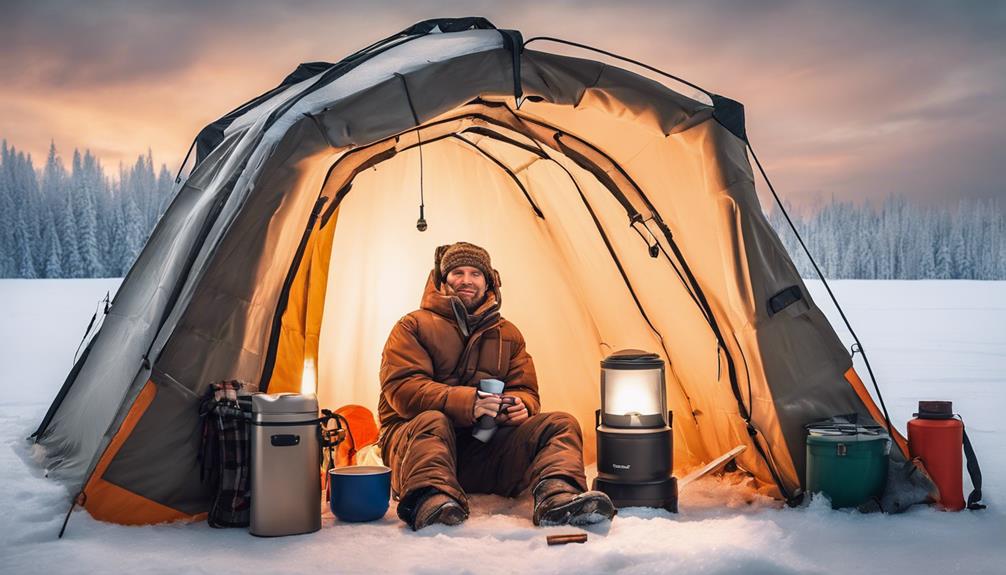
Ensuring your clothing layers are properly insulated is crucial for staying warm and comfortable during your ice fishing excursion. When preparing for a day on the ice, layering is key. Start with a moisture-wicking base layer to keep sweat away from your body.
Next, add an insulating layer like a fleece jacket or wool sweater to trap heat. Finally, top it off with a waterproof and windproof outer layer to shield you from the elements. This layering system will help you regulate your body temperature as you move between the cold outdoors and potentially warmer ice shanties.
In addition to clothing, portable heaters can be a game-changer in staying cozy during long hours on the ice. Portable propane heaters are popular choices, providing a steady source of heat in small spaces like ice fishing shelters. Make sure to follow all safety guidelines when using these heaters, such as ensuring proper ventilation to prevent carbon monoxide build-up.
Having a reliable heat source can make your ice fishing experience much more enjoyable, especially on those bitter cold days.
Preparing Your Catch
As you reel in your prized catch, knowing how to effectively prepare it for consumption can enhance your ice fishing experience. Once you have your fish in hand, it's crucial to clean it properly to ensure the best taste. Here are some tips to help you make the most of your fresh catch:
- Cleaning Fish: Start by scaling the fish to remove the outer layer, then carefully gut it to remove the internal organs. Make sure to remove any remaining bloodlines or dark flesh to enhance the flavor. Rinse the fish thoroughly with cold water to clean off any debris.
- Cooking Techniques: Whether you prefer pan-frying, grilling, baking, or even smoking, choosing the right cooking technique can make all the difference in the taste of your fish. Experiment with different seasonings and marinades to find the perfect flavor profile for your catch.
- Fresh vs. Frozen: If you're not planning to cook your fish immediately, consider freezing it to preserve its freshness. Properly wrapping and freezing your fish can help maintain its flavor and texture for future meals.
- Sharing the Bounty: If you've caught more fish than you can eat, consider sharing your catch with friends and family. Sharing the fruits of your labor can't only spread joy but also create lasting memories with your loved ones.
Frequently Asked Questions
How Do I Properly Maintain My Ice Fishing Gear to Ensure Longevity?
To properly maintain your ice fishing gear for longevity, make sure to store your equipment in a dry place to prevent rust and damage.
Regularly clean your gear using gentle soap and water to remove dirt and debris. Dry everything thoroughly before putting it away.
What Are Some Common Mistakes to Avoid for Beginners When Ice Fishing?
When ice fishing as a beginner, safety precautions are key. Always check ice thickness, wear appropriate gear, and never go alone.
Additionally, equipment care is crucial. Keep your gear organized and clean to prevent damage. Avoid common mistakes like overloading your sled or not properly securing your shelter.
Are There Any Regulations or Restrictions I Need to Be Aware of Before Going Ice Fishing?
Before heading out for ice fishing, be sure to check the permit requirements and fishing boundaries in your area. It's crucial to follow regulations to avoid any legal issues.
Additionally, always prioritize safety precautions, especially in icy conditions. Keep an eye on the weather forecast and be prepared for changing conditions.
How Can I Determine the Thickness of the Ice Before Venturing Out Onto the Frozen Lake?
To determine ice thickness safely, start by drilling test holes with an auger every few feet as you walk towards your fishing spot. Measure the thickness using a tape measure or ice chisel.
Remember, clear blue ice is the strongest. Always prioritize safety precautions like wearing a life jacket and carrying ice picks. Regularly check ice thickness and stay away from areas with flowing water.
Proper gear maintenance ensures a successful ice fishing adventure.
What Emergency Safety Measures Should I Have in Place While Ice Fishing?
When ice fishing, always prioritize safety. Make sure you have emergency communication devices like a fully charged cell phone or a two-way radio. Additionally, take ice safety precautions seriously by wearing a flotation suit, carrying ice picks, and knowing how to self-rescue in case of an accident.
Being prepared and cautious can help ensure a safer ice fishing experience.
Conclusion
Now that you have the basics down, it's time to hit the ice and start reeling in those fish!
Remember to always prioritize safety, choose the right gear, and stay warm and comfortable.
With practice and patience, you'll soon become a pro at ice fishing.
So grab your gear, find the perfect spot, and enjoy the peaceful serenity of ice fishing.
Good luck and tight lines!
